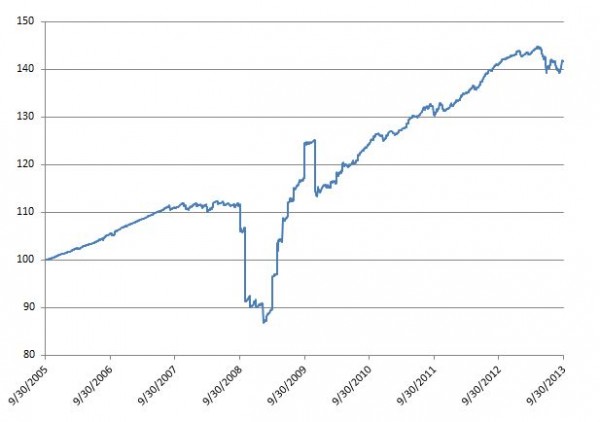Most people think of VIX as simply an index. This makes sense — the “I” in VIX stands for that very word. But VIX is more useful than your average index. It could easily be grouped with economic indicators, like the unemployment percentage or new home sales. Why? Because the VIX level — not just the changes in that level — contains valuable information. In this post I will show you how, with some high school math, you can extract this information and arm yourself with knowledge that will inform your investment decisions.
VIX is not your typical index
When an index provider starts calculating a new index, they will choose a starting point, a base level. This can be any number — 100, 1000, or even a million. Investors correctly don’t pay much attention to that. It’s the percentage changes in this index, driven by the increases and decreases in value of the securities it comprises, which are of most value to the market.
In the case of VIX, movements up and down are important as well. However, the actual VIX level means something too. It communicates the 30-day implied volatility of the S&P 500. In a previous post, I explained what this means.
But how can we arrive at the 30-day implied volatility? How do we convert the current VIX level into this information? This isn’t hard, but it does require some simple math. Here are the two steps.
- Turn the VIX level into a percentage. So, a VIX level of 15 equates 15%. This is the annualized implied 30-day volatility for the S&P 500.
- Deannualize VIX to turn it back into its true monthly measure. The formula for this is to divide the VIX level, as a percentage, by the square root of 12, the number of months in a year.
This table shows how VIX levels translate into 30-day implied volatility figures using this approach.
You may wonder why we would divide by the square root of 12. My advice is to put this deep question aside and to concentrate on the basics. For now, it is sufficient to know that you can back out the 30-day implied volatility from the VIX level with this simple formula.
Understanding what “volatility” is in the context of VIX
The implied 30-day volatility of the S&P 500 tells you the likely range of possible index levels the market “expects” in a month. If the implied 30-day volatility is 4.3% — which equates a VIX level of 15 — then this means that the market expects the index to have a return that is within a range that spans 4.3% higher and 4.3% lower than the index level.*
We say “expects” because the market isn’t sure and is instead communicating what will probably happen. You will remember from your basic statistics courses that when someone brings up probability, a bell curve soon follows. This blog post is no exception.
Below is a normal distribution, the most common type of probability distribution that supposes that most data points will fall near the average. On this type of curve, one standard deviation comprises about 68% of likely outcomes. In our case, the data points in the bell curve are possible index levels the S&P 500 could arrive at 30 days from now. The 30-day implied “volatility” that VIX conveys is one standard deviation in the bell curve, which is centered on the index level.
Putting this knowledge into practice
Now that you know the basics, let’s use them. Assume that today, the S&P 500 level is 1710 and the VIX level is 18. What additional information can you extract from these two data points?
As a first step, turn the VIX level into the 30-day implied volatility:
Turn VIX into a percentage: VIX = 18 = 18%
Then deannualize it: 18% / √12 = 5.20%
Second, apply this percentage to the index level:
1710 x 5.20% ≈ 89
Third, subtract and add this amount to the index level to tell you the range the market expects the S&P 500 to trade in 30 days from now, with a 68% confidence level:
1710 + 89 = 1799
1710 – 89 = 1621
The range between these numbers, 1621 to 1799, is where the market expects the S&P 500 to trade in 30 days, with a reasonably high level of confidence. You may agree or disagree with this, but this is what the market believes, and this is a powerful starting point around which to build an investment strategy.
* Using the current index level is a helpful shortcut. In reality, the probability curve is centered around the forward price of the index, which is the current index level adjusted for various payments the investor hypothetically might have received or lost, including interest, dividends, and income from stock lending. Making these adjustments matters less if you are only looking ahead a short time and if interest rates and dividends are low.
The posts on this blog are opinions, not advice. Please read our Disclaimers.






